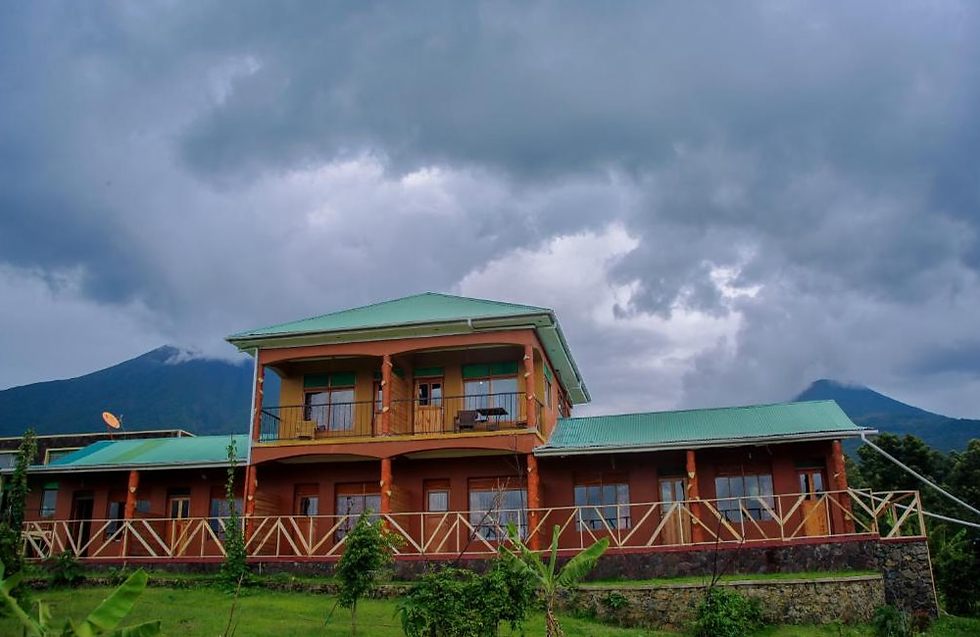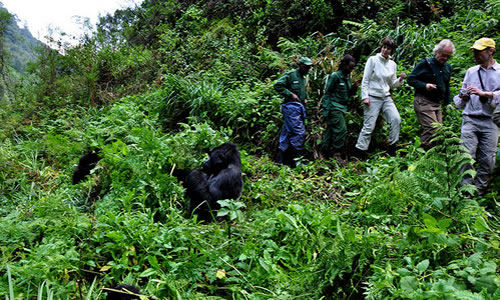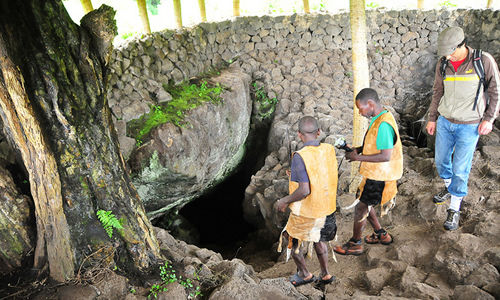
Mgahinga Gorilla National Park
2025 Guide to Mgahinga
Tucked in the southwestern corner of Uganda, Mgahinga Gorilla National Park (MGNP) is the country’s smallest national park, covering just 33.7 square kilometers, yet it packs an astonishing punch of biodiversity and adventure. Nestled in the Virunga Conservation Area, bordering Rwanda’s Volcanoes National Park and the Democratic Republic of Congo’s Virunga National Park, MGNP is home to the critically endangered mountain gorillas and golden monkeys, set against the dramatic backdrop of three extinct Virunga volcanoes: Muhavura (4,127m), Gahinga (3,474m), and Sabyinyo (3,669m). Established in 1991 to protect its gorilla population, the park also holds cultural significance for the indigenous Batwa people. With activities like gorilla trekking, golden monkey tracking, volcano hiking, and Batwa cultural experiences, MGNP offers a unique blend of wildlife and adventure. This guide covers everything you need to plan your visit, from permits and accommodations to dining and conservation efforts.
MGAHINGA GORILLA National Park
2025 Guide to Mgahinga
Tucked in the southwestern corner of Uganda, Mgahinga Gorilla National Park (MGNP) is the country’s smallest national park, covering just 33.7 square kilometers, yet it packs an astonishing punch of biodiversity and adventure. Nestled in the Virunga Conservation Area, bordering Rwanda’s Volcanoes National Park and the Democratic Republic of Congo’s Virunga National Park, MGNP is home to the critically endangered mountain gorillas and golden monkeys, set against the dramatic backdrop of three extinct Virunga volcanoes: Muhavura (4,127m), Gahinga (3,474m), and Sabyinyo (3,669m). Established in 1991 to protect its gorilla population, the park also holds cultural significance for the indigenous Batwa people. With activities like gorilla trekking, golden monkey tracking, volcano hiking, and Batwa cultural experiences, MGNP offers a unique blend of wildlife and adventure. This guide covers everything you need to plan your visit, from permits and accommodations to dining and conservation efforts.

Mgahinga's Attractions and Activities
gorilla tracking
Gorilla trekking is MGNP’s star attraction, focusing on the Nyakagezi gorilla family, a transboundary group of nine members, including a 50-year-old silverback named Bugingo. Treks start at 8:00 AM from Ntebeko gate with a briefing, followed by a 30-minute to 7-hour hike through bamboo and montane forests. The forest is less dense than Bwindi, making sightings easier, with a near-100% success rate. Visitors spend one hour with the gorillas, observing their behaviors. Permits cost $800 for foreign.
golden monkey trekking
MGNP is Uganda’s only destination for tracking endangered golden monkeys, an Albertine Rift endemic found in bamboo forests. Treks, starting at 7:30 AM, take 30 minutes to 3 hours, as these agile primates move frequently. Less strenuous than gorilla trekking, the activity costs $100 for non-residents and allows one hour with the monkeys, offering playful encounters and photo opportunities. Book permits through the Uganda Wildlife Authority (UWA).
volcano hiking
MGNP’s three Virunga volcanoes offer challenging yet rewarding hikes:
-
Mount Muhavura (4,127m): An 8-hour, 12km round trip to a crater lake, with views of Bwindi and the Rwenzoris.
-
Mount Sabyinyo (3,669m): An 8-hour, 14km hike to a summit straddling Uganda, Rwanda, and DRC, with gorges and ravines.
-
Mount Gahinga (3,474m): A 6-hour trek to a swamp-filled crater, featuring giant lobelias.
Hikes cost $80-$100, requiring good fitness. Guides and porters assist, and caves along slopes add intrigue.
Bird Watching
With over 180 bird species, including 14 Albertine Rift endemics like the Rwenzori turaco and dusky crimsonwing, MGNP is a birding hotspot. Trails like the Sabyinyo Gorge and bamboo forest are ideal for spotting species such as the regal sunbird. Guided birding tours ($30-$50) enhance sightings, especially in the wet season (March-May, September-November) when migratory birds arrive.
batwa trail experience
The Batwa, the forest’s original inhabitants, offer cultural tours ($80 for non-residents) showcasing their hunting, gathering, and medicinal plant knowledge. Visit the sacred Garama Cave, once a Batwa royal residence, and enjoy traditional songs and dances. These tours, led by Batwa guides, support community livelihoods.
nature walks
Guided walks ($30-$50) explore the Sabyinyo Gorge, bamboo trails, or border viewpoints, revealing flora, fauna, and volcanic landscapes. Less strenuous than volcano hikes, they suit various fitness levels and offer chances to spot buffalo or bushbuck.






How to Get to mgahinga gorilla National Park
MGNP is accessible by air or road from Kampala, Kigali, or nearby parks.
-
By Air: Daily flights from Entebbe International Airport or Kajjansi Airfield to Kisoro Airstrip (90 minutes, $200-$400 one-way) via Aerolink Uganda, followed by a 14km drive to Ntebeko gate. Book early for peak seasons.
-
By Road: From Kampala, the 510km drive (9-10 hours) via Masaka, Mbarara, Kabale, and Kisoro requires a 4x4, especially in wet seasons. From Kigali, Rwanda, it’s a 3-4 hour drive (150km) via the Cyanika border, a faster option. Public buses from Kampala to Kisoro are available but less reliable ($10-$20).
-
Visa Requirements: Uganda visas ($50) are obtained online or on arrival. The $100 East African Tourist Visa covers Uganda, Rwanda, and Kenya. Carry a yellow fever vaccination certificate.
-
Park Gate: Ntebeko gate, 14km from Kisoro, is the main entry, with clear signage from town.
BEST TIME TO VISIT
MGNP is open year-round, but seasons impact trekking conditions.
-
Dry Seasons (June-October, December-February): Ideal for gorilla trekking and hiking, with less muddy trails and clearer views. Book permits 4-12 months in advance due to high demand for the eight daily gorilla permits.
-
Wet Seasons (March-May, September-November): Lush scenery and fewer crowds, but trails are slippery. October is wettest (250mm rain), July driest (10mm). Permits are easier to secure.
Temperatures average 17°C (63°F) due to high altitudes (2,227-4,127m), with chilly mornings and nights. Pack warm, waterproof clothing.
Park Fees and Permits
Fees are set by UWA to fund conservation.
-
Gorilla Trekking Permit: $800 (non-residents), $700 (residents), UGX 250,000 (~$67) (East Africans).
-
Golden Monkey Trekking: $100 (non-residents), UGX 370,000 (~$100) (East Africans).
-
Batwa Trail: $80 (non-residents), UGX 50,000 (~$13) (East Africans).
-
Volcano Hiking: $80-$100 per person.
-
Park Entrance: $40/day (non-residents), UGX 20,000 (~$5) (East Africans).
-
Booking: Secure permits via UWA (reservations@ugandawildlife.org) or tour operators like Mountain Gorilla Coffee Tours. Book gorilla permits early, as only eight are issued daily.
WHERE TO STAY
MGNP has no lodging inside the park, but nearby options in Kisoro and Lake Mutanda cater to all budgets.
-
Luxury: Mount Gahinga Lodge offers upscale bandas with volcano views and spa services. Chameleon Hill Lodge (Lake Mutanda) provides colorful chalets and lake vistas.
-
Mid-Range: Mucha Hotel and Kisoro Travelers Lodge in Kisoro offer comfortable rooms with Wi-Fi and meals.
-
Budget: Mgahinga Community Camp and Amajambere Iwacu Community Camp provide basic bandas or camping near Ntebeko gate.
-
Community-Based: Batwa homestays near Kisoro blend affordability with cultural immersion.
Book early, especially in dry seasons. Most lodges include meals and arrange transfers to Ntebeko.


DINING AT mgahinga gorilla
Dining near MGNP blends Ugandan staples with international touches, often with volcano or lake views. Enjoy matoke (steamed bananas), luwombo (stew in banana leaves), and grilled tilapia from Lake Mutanda at lodges like Mount Gahinga Lodge, which emphasizes farm-fresh ingredients. Budget options like Mgahinga Community Camp serve kalo (millet bread) and rolex (egg-chapati roll), a local favorite. Coffee tastings, featuring Kisoro’s robust beans, are popular at Chameleon Hill Lodge. Most accommodations cater to vegetarian, vegan, or gluten-free diets with advance notice, offering a taste of Uganda’s culinary heritage amidst stunning scenery.
Packing List & Preparation
Prepare for high-altitude, wet conditions.
-
Clothing: Waterproof hiking boots, long-sleeved shirts, trousers, rain jacket, gloves (for vines), hat, warm layers. Neutral colors for treks.
-
Gear: Trekking poles, binoculars, camera (no flash), insect repellent, sunscreen, reusable water bottle, daypack.
-
Health: Yellow fever vaccination (required), malaria prophylaxis, personal medications, first aid kit. Moderate fitness is needed for treks and hikes.
-
Other: Cash (USD/UGX) for tips ($10-$20 for porters/guides), souvenirs, permit confirmations, passport.
Hiring porters ($15-$20) supports locals and eases treks.
Safety & Conservation
MGNP is secure with robust measures.
-
Safety: Armed UWA rangers escort all activities, backed by Uganda Army patrols and tourism police. The park is safe, with no major incidents reported recently.
-
Gorilla/Monkey Health: Maintain 7-8m distance, avoid eating/drinking near animals, and don’t trek if ill to prevent disease transmission.
-
Conservation: Permit fees fund gorilla and monkey protection, anti-poaching patrols, and Batwa community projects. The Nyakagezi group’s residency in MGNP has stabilized, boosting conservation success. Avoid littering to preserve habitats.



FAQ
What is the best time for gorilla trekking in MGNP?
Dry seasons (June-October, December-February) for easier trails; wet seasons (March-May, September-November) for fewer crowds.
How much is a gorilla permit?
$800 for non-residents, $700 for residents, $1,500 for habituation (not offered in MGNP).
Is mgnp safe?
Yes, with armed rangers, army patrols, and tourism police ensuring security.
how fit do i need to be?
Moderate fitness for treks and hikes; porters assist less experienced visitors.
Can I combine MGNP with Bwindi?
Yes, the parks are close, and many operators offer dual-trekking itineraries.

